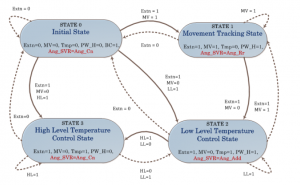State-Based Temperature Control
In this post, we talk about State-Based Temperature Control.
The Smart Localized Heating Control (SLHC) system has the state-based temperature control function. Figure shows the finite state machine (FSM) that is embedded in the Smart Processing and Controlling (SPC) Unit of the SLHC system. The FSM model consists of four states based on movement sensing and temperature feedback conditions. Each state has a unique action and the requirements to move next state. Depending on the selected state, the heater’s direction and power are controlled.

The SLHC system is designed to provide the ideal thermal condition to the user. Consequently, the temperature is one of the core inputs to the system. The temperature monitoring is important to prevent the thermal discomfort and the damage caused by overheating. The SLHC system has the method to control the applied temperature based on the feedback and the effective heater operation control.
To design an optimum temperature control function in the system, consider several things related the heater’s operation. First of all, consider how the heater’s operation affects human thermal sensation in various situations. Also, the feedback inputs to operate the heater must be decided. Lastly, the method of temperature control in the SLHC system and the expected outcomes of the system operation must be discussed.


